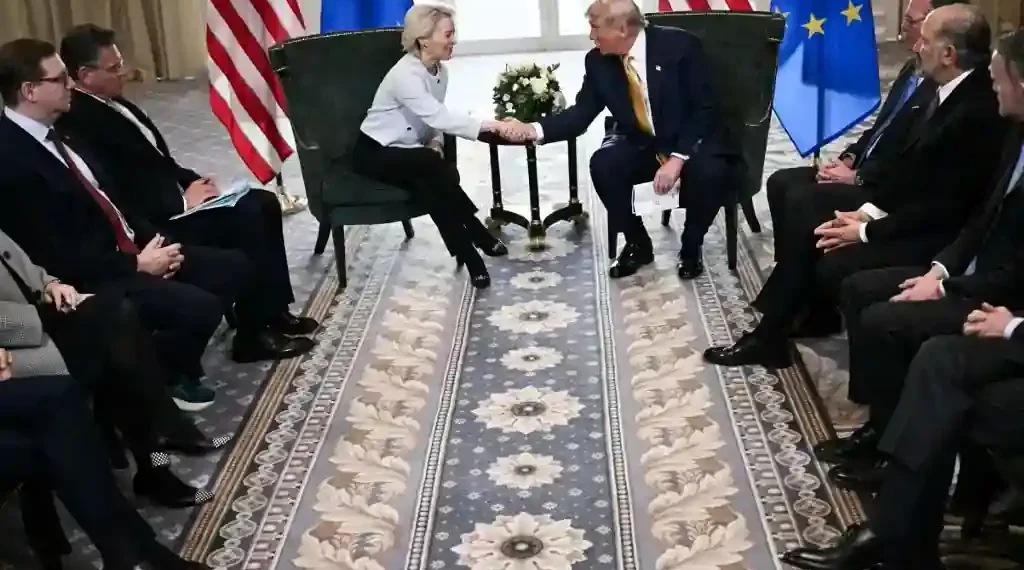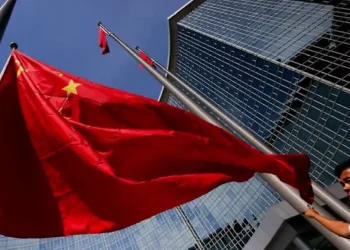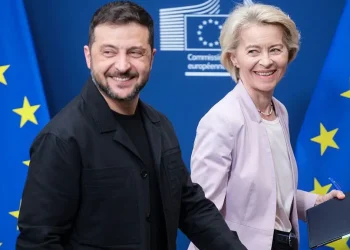Trump and EU Reach Trade Deal to Avoid Tariff War
July 28, 2025 – 22:00 EDT
The United States and the European Union have struck a last-minute trade agreement that prevents a full-scale tariff war between two of the world’s largest economies. While the framework provides a sense of relief and stability, it introduces new tariffs that could raise prices and cause uncertainty in transatlantic trade relations.
A deal reached under pressure
After months of tense negotiations, the U.S. and EU finalized a trade agreement just before an August 1 deadline that would have triggered heavy reciprocal tariffs. The breakthrough came after former President Donald Trump, during a trip to Scotland, met with European Commission President Ursula von der Leyen to hammer out a broad framework.
The deal imposes a 15% baseline tariff on most European goods entering the United States—a significant increase from the pre-Trump average of 1.2%, though less than the 50% tariff Trump had previously threatened. For many, the agreement represents damage control rather than triumph.
“We made it,” Trump said during the announcement. “It’s going to work out really well.”
Von der Leyen echoed the sentiment, calling the deal a chance to “rebalance but enable trade on both sides.”
Avoiding economic fallout
Prior to the agreement, both sides had threatened retaliatory measures that risked harming key industries, disrupting supply chains, and straining global economic growth. The U.S. was preparing steep tariffs targeting European steel, aluminum, pharmaceuticals, and automobiles, while the EU had drafted countermeasures aimed at strategic American exports.
According to Jörn Fleck, senior director of the Atlantic Council’s Europe Center, the agreement likely prevented what could have been “a self-destructive trade war” between two of the globe’s largest commercial and investment partners.
Stock markets responded positively. Dow futures rose by 150 points, while S&P 500 and Nasdaq futures also saw modest gains.
What the deal includes
Though still light on specifics, the deal outlines several key commitments:
- Europe will invest $600 billion in the U.S.
- EU pledges to buy $750 billion worth of American energy products
- Tariffs will be eliminated on items including aircraft parts, semiconductors, chemicals, and some agricultural products
Airlines for America issued a statement praising the zero-tariff segment of the deal, saying it “will grow jobs, strengthen our economic security, and provide a framework for U.S. leadership in manufacturing and safety.”
However, many of these investments were already underway, according to Maury Obstfeld of the Peterson Institute for International Economics. He expressed concern that the agreement does little to address long-standing non-tariff barriers such as digital service taxes and complex value-added tax schemes in the EU.
Tariffs still sting for many sectors
Despite the relief, several industries are bracing for higher costs. The 15% tariff will apply broadly, impacting sectors beyond those granted exemptions.
Joe Brusuelas, chief economist at RSM, warned that consumers will likely feel the effects:
“You’re going to pay more for your European imports. That’s what this means.”
Automotive manufacturers were among the most vocal critics. The 15% auto tariff on EU cars falls below the 25% tariff applied to cars built in Mexico, undercutting American carmakers’ competitiveness. This echoes similar frustrations after the U.S.–Japan trade agreement, which left Detroit automakers at a disadvantage.
Although von der Leyen noted that pharmaceuticals were included in the framework, she admitted that future tariff hikes on imported drugs remain a possibility, potentially undermining one of the more sensitive sectors of the agreement.
Relief, but no celebration
While the agreement avoids immediate economic fallout, it falls short of resolving the broader disputes that have long complicated U.S.–EU trade relations. Many experts see the deal as a temporary fix rather than a long-term solution.
“There are many things that puzzle me about this agreement,” said Obstfeld, highlighting the vague language and lack of enforceable mechanisms. He and others warn that the agreement could unravel if details are not clarified and mutually beneficial implementation is not achieved.
Still, the mood in Washington and Brussels leans more toward cautious relief than celebration.
“We avoid a tit-for-tat retaliation between Washington and Brussels that would’ve spilled over into the far more important services sector,” Brusuelas said.
Next steps: defining the deal
With the framework in place, negotiators must now focus on the fine print. Details regarding enforcement, sector-specific guidelines, and dispute resolution mechanisms remain unclear. Analysts expect further rounds of dialogue before a final agreement can be signed and implemented.
Meanwhile, businesses on both sides of the Atlantic are watching closely, trying to understand how the deal will affect their operations and bottom lines.
The outcome of these talks could shape the future of transatlantic trade policy for years to come, especially as geopolitical tensions continue to influence global economic strategy.
This article was rewritten by JournosNews.com based on verified reporting from trusted sources. The content has been independently reviewed, fact-checked, and edited for accuracy, neutrality, tone, and global readability in accordance with Google News and AdSense standards.
All opinions, quotes, or statements from contributors, experts, or sourced organizations do not necessarily reflect the views of JournosNews.com. JournosNews.com maintains full editorial independence from any external funders, sponsors, or organizations.
Stay informed with JournosNews.com — your trusted source for verified global reporting and in-depth analysis. Follow us on Google News, BlueSky, and X for real-time updates.














